 Pamela Sneed
Pamela Sneed
In a show of over forty monumental photographs, a reclamation
of agency for the Black body.
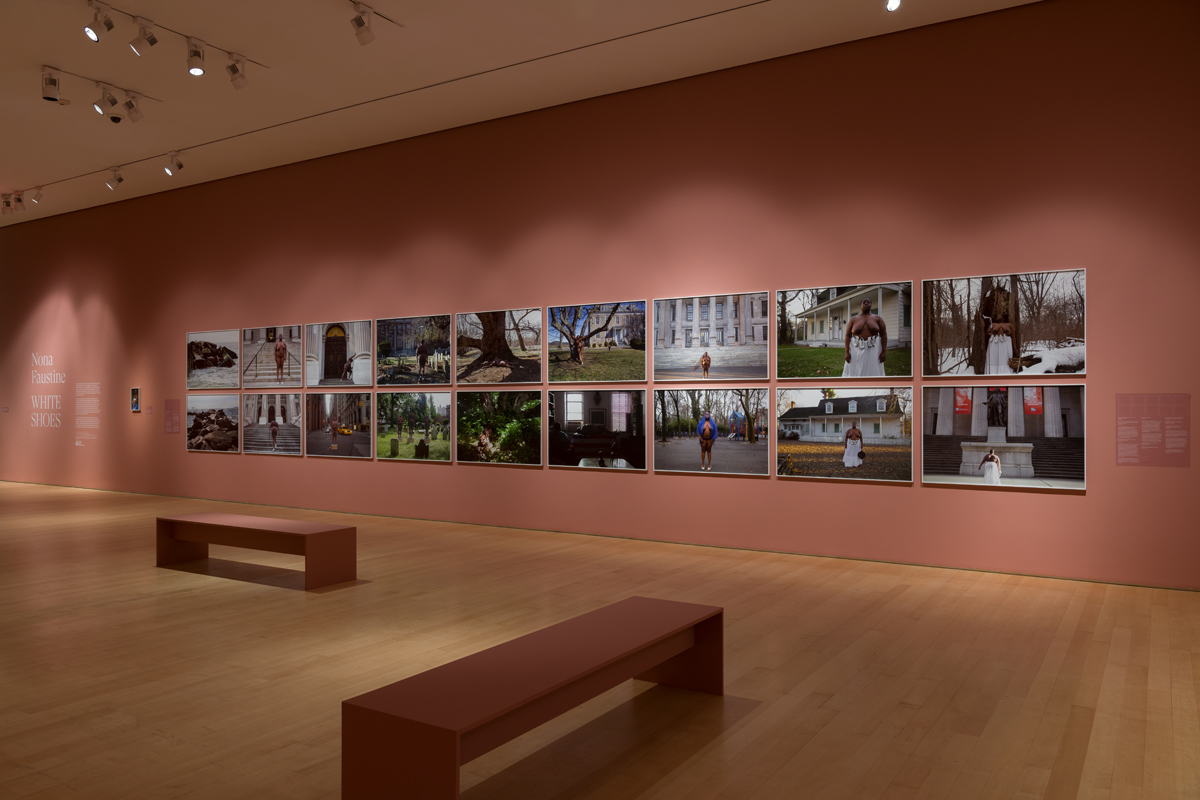
Nona Faustine: White Shoes, installation view. Courtesy Brooklyn Museum. Photo: Paula Abreu Pita.
Nona Faustine: White Shoes, organized by Catherine Morris with Carla Forbes, Brooklyn Museum, 200 Eastern Parkway, Brooklyn, New York, through July 7, 2024
• • •
At a time when people pass through galleries and museums at a pace almost akin to internet scrolling, I was struck by the ten, twelve, even thirty minutes people stood or sat to contemplate the images in Nona Faustine’s Brooklyn Museum exhibit, White Shoes. Consisting of more than forty photographs, installed together for the first time, White Shoes is an ongoing series. The artist marks with her nude body former slave sites in New York, from Wall Street to Prospect Park, Flatbush, and more.

Nona Faustine, Isabel, Lefferts House, Prospect Park, Brooklyn, NY, 2016. Courtesy the artist and Higher Pictures.
Though a longtime admirer of Faustine’s artistic practice, viewing this exhibit I was captivated, moved in entirely new ways, and gained new information. Reading the accompanying wall text, I was stunned to learn New York was the second-largest slaveholding city. “By 1730, approximately 42 percent of New York City’s white households held Africans in bondage”—so much for the mythology of Northern Liberalism. Because of this little-known and disregarded history, the way the past and present are merged, coupled with the beauty of Faustine’s Black body that transforms into sculpture blending with and into landscape, you cannot look away. The artist’s work is reminiscent of photographs by Laura Aguilar in her “Nature Self-Portrait” series, where her body mimics landscape. Near the start of White Shoes, Faustine is splayed over the rocks of the Atlantic Ocean at Coney Island, the same Atlantic where slave ships carried human cargo from Africa to the Caribbean and United States.

Nona Faustine: White Shoes, installation view. Courtesy Brooklyn Museum. Photo: Paula Abreu Pita.
The subject matter and large scale of the photographs make this show monumental (all but two images are 33 3/8 by 50 inches). Their dimensions not only center and hold the fullness of Faustine’s body but, most importantly, the immense scale of her vision. Faustine gestures toward and invokes nameless Black slaves and ancestry buried beneath the city. Under the halls of justice and government in New York City lie skeletons, their bones speak.
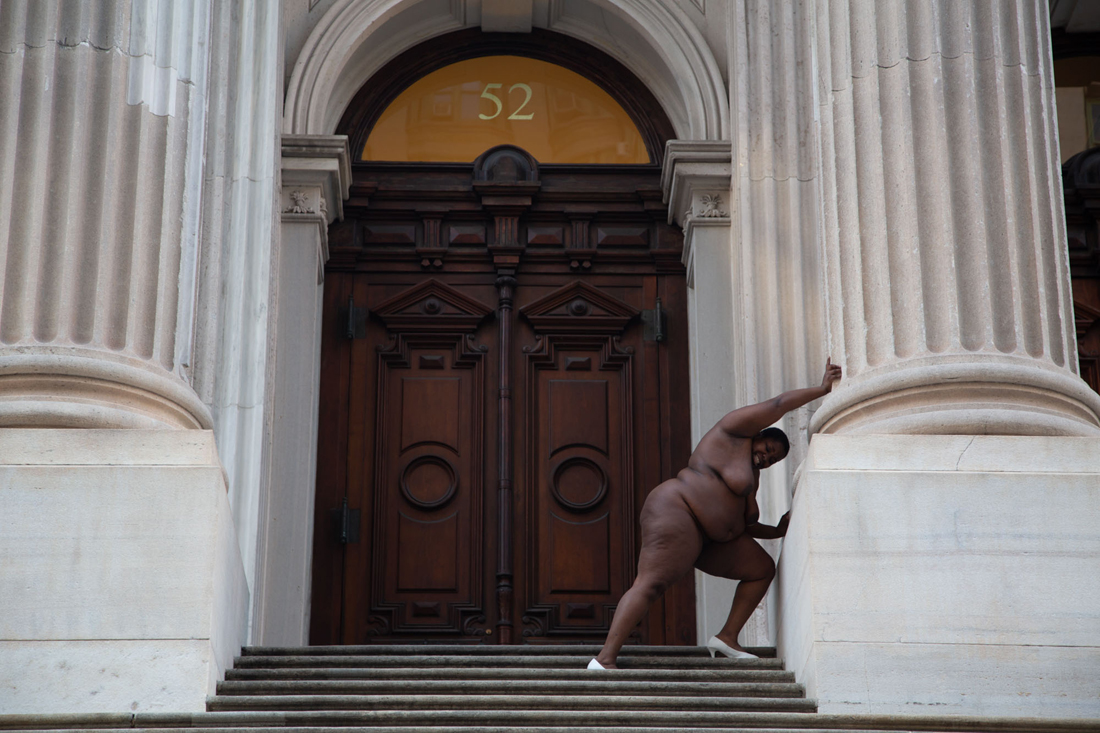
Nona Faustine, They Tagged The Land With Trophies And Institutions From Their Rapes And Conquests, Tweed Courthouse, NYC, 2013. Courtesy the artist and Higher Pictures.
In her nudity Faustine also alludes to Sara Baartman, from South Africa, known as the Hottentot Venus, who was exhibited as a freak show in nineteenth-century Europe. Her large genitalia and buttocks were a curiosity to whites. In contrast to her nakedness, Faustine’s feet are clad in white heels (hence the series title). Paraphrasing the artist’s words, they symbolize church-lady pumps and the ever-present white patriarchy, colonialism, and domination. I interpret the white shoes worn in each photo as a means of movement and transport. They represent what Black women have been denied publicly and privately. Because of racism, misogyny, and more, what is often denied is agency. Faustine, in control of the camera and the lens, offers reclamation. In this case, as a photographer, she is a performance artist, historian, sculptor, shaman cutting across disciplines. She stages interventions that disrupt dominant narratives. She inserts Blackness in a momentous field of erasure. In the photograph They Tagged The Land With Trophies And Institutions From Their Rapes And Conquests, Tweed Courthouse, NYC, Faustine pushes against a monstrous white column symbolizing her and our continuous fight for justice. In I Like Tea With My Plato, she is dressed in white, with a regal scarf draped over her shoulder, drinking tea, reading a book, luxuriating on a great rock of the former free colony Seneca Village in Central Park. It is a balm for a people once forbidden to read.
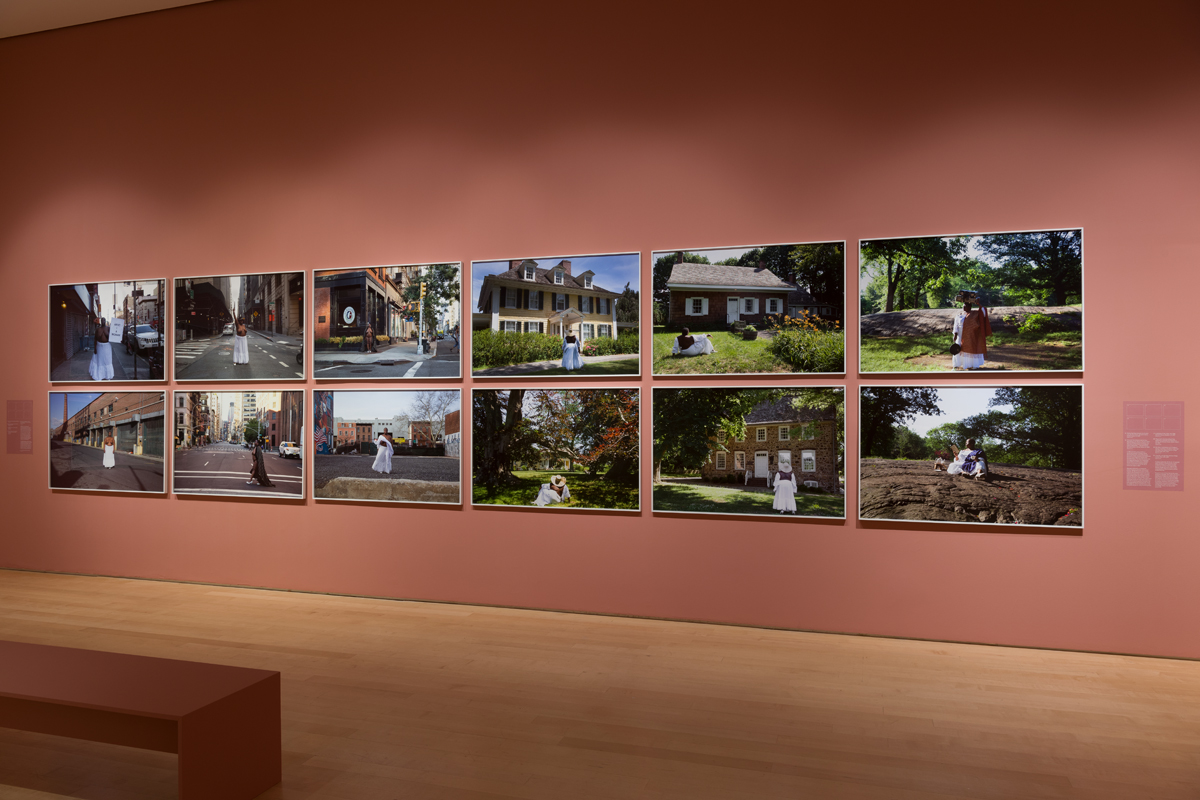
Nona Faustine: White Shoes, installation view. Courtesy Brooklyn Museum. Photo: Paula Abreu Pita.
Faustine’s images, and certainly their titles, are poetry. They are sly, full of wit, meaning, confrontation, and double entendres. For instance, the photograph where she stands on Wall Street on a makeshift auction block, her wrist wearing a shackle, is titled From Her Body Came Their Greatest Wealth. She poses on what was a literal slave market in New York’s financial district. The title states the enormous wealth white slave owners and businessmen acquired from the slave trade but also points to her positionality as a mother, one who has given birth. This also provides commentary on Black women who were continuously bred for profit in slavery.
Years back, Kara Walker’s mammoth white-sugar sphinx, a sculpture with an oversize vulva and buttocks, also nodded to the slave trade, sugar, and to Sara Baartman. Ironically, she titled this work A Subtlety, or the Marvelous Sugar Baby, an Homage to the unpaid and overworked . . . . (Subtleties were also sugar ornaments served at banquets for the elite in the sixteenth century.) As a poet, in a real sense of the word, I search for the subtlety in each of Faustine’s photographs. In one, where she stands in a cityscape in full confrontation, I humorously notice a small exit sign on a building in the right-hand corner. In another cityscape with the artist at the fore, in the background I notice a red crane the shape of an X that, marking the spot, underscores the historical wrong presented.

Nona Faustine, Walk to Freedom Frederick Douglass, Church St. & Lispenard St., NYC, 2015. Courtesy the artist and Higher Pictures.
In many of the photos, trees offer a continuum, their branches and vines entwining the personal and political. The body’s physical landscape of planes and curves push and rest against an external landscape. In some pictures, the trees are gargantuan, full and lush. At other times, they are winter-bare. Like parishioners in a Black church, they testify, and bear witness. They are actors posing as limbs, torsos, feet, and heads. They cradle, offer support, majesty, shade, and camouflage. In Lobbying The Gods For A Miracle, Prospect Park, Faustine’s skin blends with brown bark. Harkening to Harriet Tubman, she holds a toy pistol. Ironically, the snow on the tree becomes smoke from the pistol. The tree forms a cylinder. There is fear or she is hiding, donning only a white peasant skirt and a belt of white baby shoes. She is naked from the waist up. The pistol represents resistance. The trees that populate many of these photos also embody a historical detail: for African Americans, they are the places where Black bodies were raped and lynched. In their extended arms and sap they hold centuries of Black blood spill.
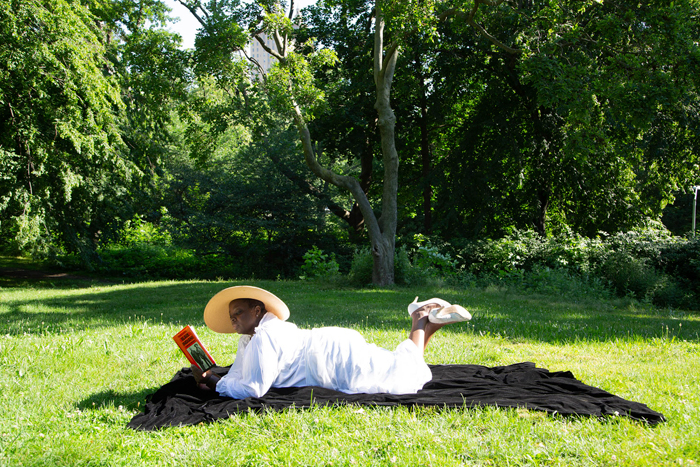
Nona Faustine, Black Indian, Andrew Williams Home Site, Seneca Village, Central Park, NYC, 2021. Courtesy the artist and Higher Pictures.
Trees are often the pillars in a landscape. In another photo, Faustine’s mother, who passed a few years ago, looks on. She was the pillar of the family, a beloved matriarch. White Shoes is a show about pillars and monuments. In counterpoint to Faustine’s confrontation of monuments, she is critiquing and exposing the pillars of our society, those erected on war, bloodshed, greed, and crimes against women and Black and brown people, leading us right up until today.
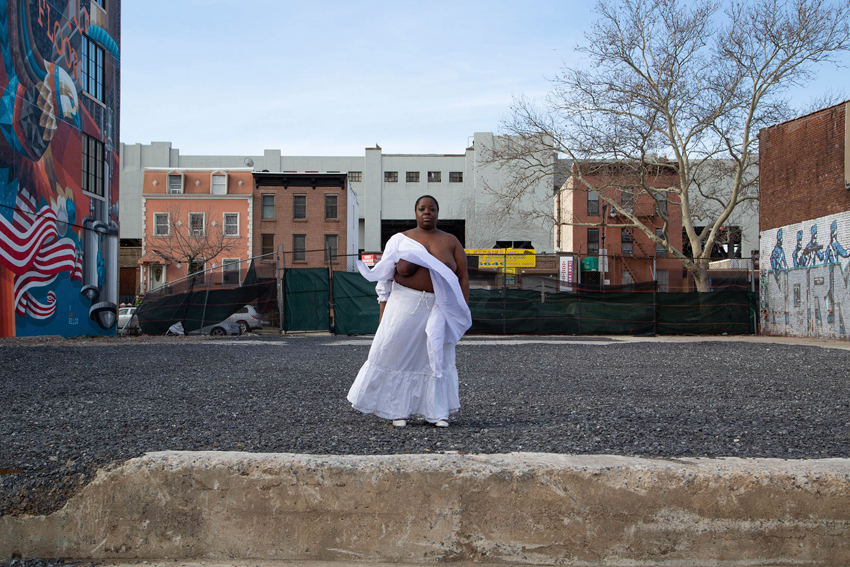
Nona Faustine, Ye Are My Witness, Brooklyn, NY, 2018. Courtesy the artist and Higher Pictures.
Writing now, I am reminded of the thousands of Blacks from the diaspora who visit Ghana, Senegal, and other West African countries to view former slave sites each year. They pass through makeshift archways and portals to symbolize the return of Africa’s stolen and lost children. With this in mind, and because Nona Faustine is a Brooklyn native who grew up in Crown Heights with an awareness and admiration of the Brooklyn Museum (she even volunteered there for a time), I view this installation as a homecoming. Her exhibition is adjacent to the seminal presentation of Judy Chicago’s Dinner Party, created to combat the erasure of women from the art world. At Chicago’s table, only two brown women are represented, Sojourner Truth and Sacajawea. In this context, Faustine’s representation of and regard for Black female figures is overdue. Like Chicago’s Dinner Party, White Shoes should be a permanent exhibition.
Recently, I spoke with an African American student who was making a short film about themes of Sankofa and was shooting at the site of a former plantation in Georgia. I said to him, “The work you’re doing is greater than the individual, you are working in service of humanity.” Like the work of Faustine, it is a call.
Pamela Sneed is a poet, performer, visual artist, and educator. She is the author of Funeral Diva (City Lights, 2020). She teaches across disciplines in Columbia University’s visual arts MFA program, and is a guest faculty member in the Whitney ISP.